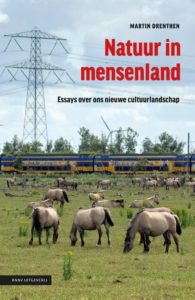The meaning of new nature in a cultured landscape
[Recensie] In ten thoughtfully arranged essays environmental philosopher Martin Drenthen shows that nature and culture are more intertwined than we might think. The essays collected in Natuur in mensenland [Nature in man’s land] cover a wide array of topics; from the question of ‘real nature’ to the readable landscape, and from the value of land art to our (paradoxical) longing for wilderness. The central theme that connects all these writings is the meaning of new nature in a cultured landscape, mostly related to Dutch nature conservation policies. Although Natuur in mensenland is a collection of essays, of which most are already published elsewhere, the editing and systematic ordering of the independent chapters transforms the initial assemblage into a coherent whole. Throughout the book Drenthen develops an appealing and convincing narrative that sheds new light on the place of nature in our cultured landscape, or rather, on our place in nature.
Scientific worldview
The book starts with a short overview of the ways humans have understood and valued nature throughout history. With the advent of the modern scientific worldview our understanding of nature became prevalently anthropocentric. The value of nature became dependent on the human interpreter. However, Drenthen argues, in questions concerning the protection and conservation of nature and the landscape, we also find an ancient understanding of nature as an independent moral order; an order that transcends our limited human perspective. We thus relate somewhat schizophrenically to nature. Debates on the conservation of nature and the protection of cultured landscapes are therefore always characterized by both a natural and a cultural dimension. To overcome this nature-culture dualism Drenthen opts for an understanding of nature as a useful alliance, a cooperative relation between humans and the environment. Such an understanding can bring about a new perspective on our human existence. The best way to obtain this perspective is by engaging with the meaning of the place in which we dwell.
Readable landscape
In order to engage with our dwelling place, we need to understand the landscape as readable. Drenthen’s elaboration on the readable landscape is the most fascinating element of the book, for, after having read Natuur in mensenland, there will be no landscape devoid of meaning. Different stances towards nature have produced different landscapes and landscape elements. Every alteration of the landscape added a new layer that tells a story, that can be interpreted. For example, the Dutch created mounds to live on, dikes to guide rivers, and polders to bridle high water. However, this does not mean that the Dutch made their nature, since these human adjustments to the landscape are only shallow. If we truly engage with the landscape and scrape of its top layers, like a palimpsest, we can discover unexpected layers of nature that tell us something about ourselves; for we identify ourselves on the basis of the landscape we value. A readable and relatable landscape gives us security. According to Drenthen cultural and natural history synthesize in these layered palimpsest landscapes, but to distil both histories from the readable landscape we need different stories to interpret the different layers. The layered landscape is therefore necessarily characterized by a multitude of often conflicting interpretations. Nonetheless, it is only due to the controversy deriving from these interpretations that we can uncover the meaning of a landscape. In other words, the non-human world makes the human world reflect upon itself by means of its own stories about nature.
Wild nature
In the second half of the book Drenthen delves into the idea of wilderness, which is currently a hot topic among environmental philosophers. He argues that we can think of wilderness as a new way to position ourselves towards nature. Wild nature is nature unspoilt by humans; a nature that is always more than human. Because we cannot grasp the meaning of the wilderness, we do not know what to expect from this autonomous nature. At the same time we are fascinated by its radical otherness, precisely because it indicates the border between culture and nature. According to Drenthen it is the otherness that confronts us with the limitations of our human, all too human, moral framework. Rewilding in nature conservation must therefore be interpreted as a critique of human culture, for it celebrates the autonomy of non-human nature and embeds human culture within a much larger context. Thus, nature re-presents itself as the context of our human lives. To understand this we only need to engage with the landscape. In an era of human-induced environmental catastrophes – an era in which humans seem to have lost touch with nature – Natuur in mensenland is a most welcome contribution. Drenthen is capable of making complex matter manifest by translating theoretical abstractions to very concrete cases. The prose is highly accessible, which makes this urgent book a mandatory reading for every citizen of the biotic community of nature.

—
Eerder verschenen in Splijtstof
